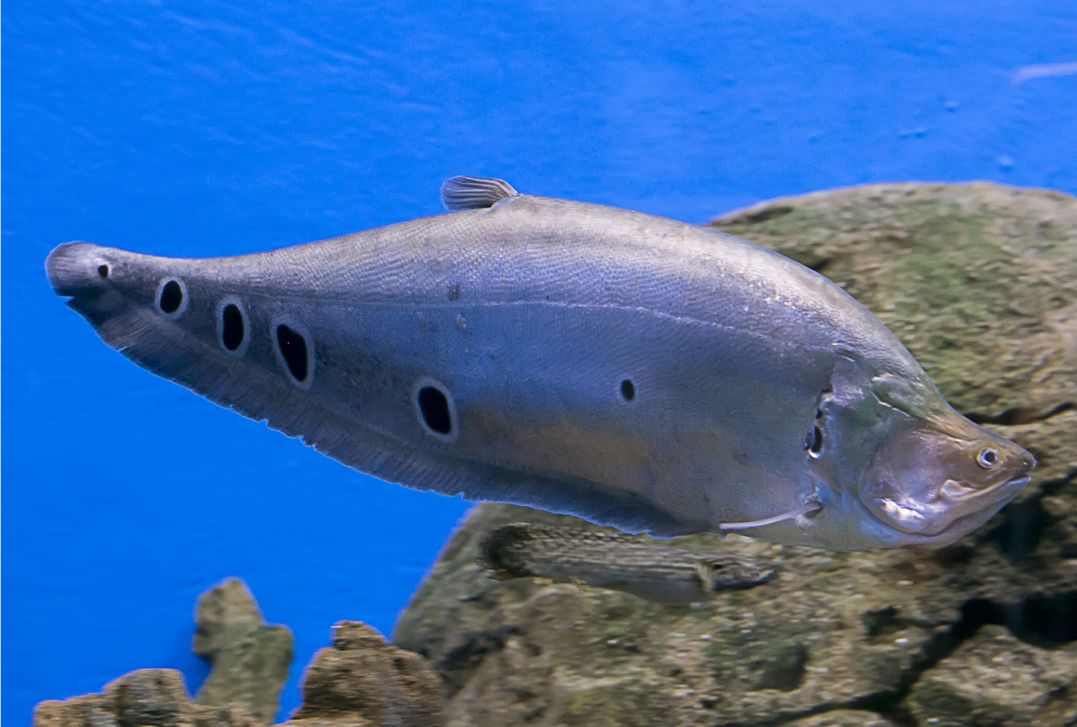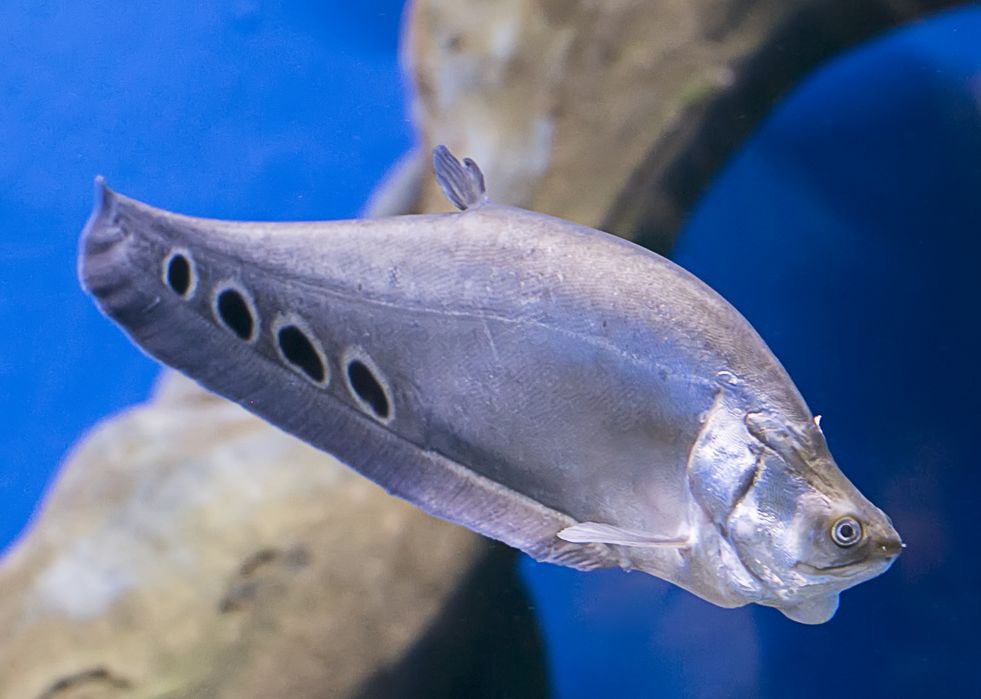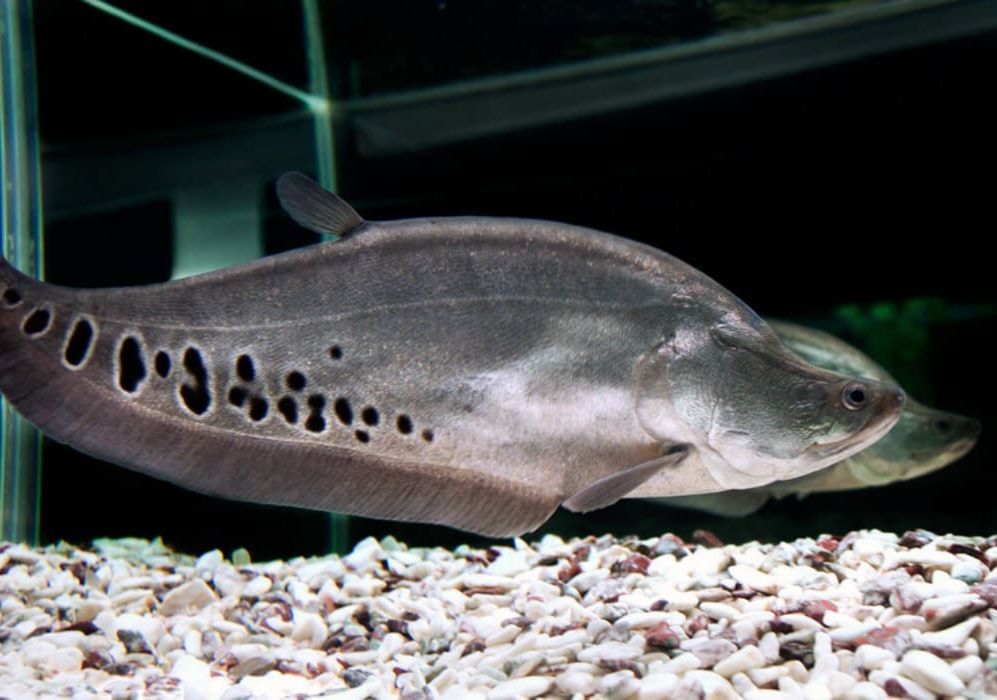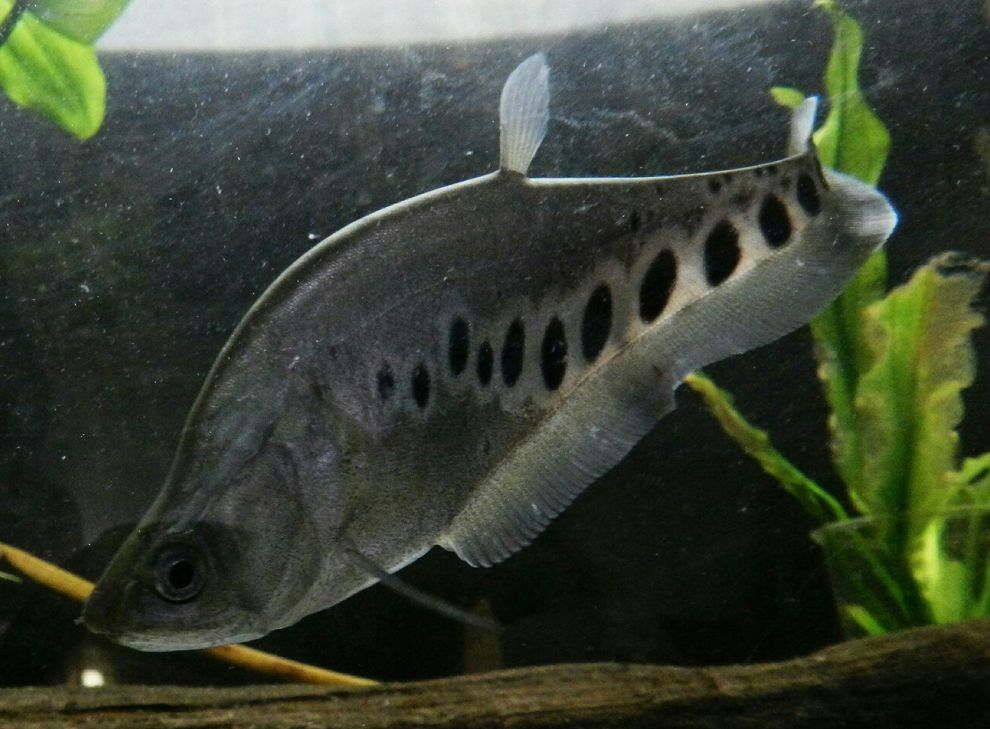Chitala ornata, commonly known as the clown knife fish or clown featherback, is a captivating freshwater species cherished by aquarium enthusiasts. With its distinctive elongated body and unique shape, this fish stands out in any aquarium setup. However, caring for the clown knife fish comes with specific considerations that potential owners should be aware of. In this article, we will explore the key aspects of keeping this remarkable fish.

Contents
Habitat in the wild
In the wild, the clown knife fish (Chitala ornata) thrives in the vast rivers of South and Southeast Asia, particularly in Thailand, Cambodia, and Vietnam. This species is commonly found in significant waterways such as the Mekong and Chao Phraya rivers. Notably, the clown knife fish has also been introduced to other regions, including Florida in the USA. Such introductions can have ecological repercussions, as Chitala ornata is considered an invasive species in these non-native habitats, posing potential threats to local ecosystems and native species.
In its natural environment, the clown knife fish inhabits lakes, swamps, floodplains, and the backwaters of large rivers. These fish prefer slow-moving or stagnant waters with abundant vegetation and submerged structures like fallen logs, tree roots, and aquatic plants. Such structures offer essential hiding spots and shelter, allowing the clown knife fish to navigate its complex habitat effectively. Their native areas are typically characterized by dense plant life, including both submerged and floating vegetation.
Juvenile clown knife fish tend to gather in groups, seeking refuge among aquatic plants and snags, while adults are more solitary, often hunting from cover among the thick vegetation. As nocturnal predators, clown knife fish conceal themselves under the roots of riverside trees and snags in warm, muddy waters. They patiently lie in wait for unsuspecting prey, ready to ambush anything small enough to swallow. Remarkably, these fish can exhibit aggressive behavior, even attacking prey that is approximately one-fourth their size.
Can You Eat Clown Knife Fish?
In their native regions, clown knife fish are commercially harvested and widely enjoyed as a food source. They are a common ingredient in the cuisine of Thailand and other Southeast Asian countries.
Description
Body
The clown knife fish features a distinctive humpbacked, elongated body that is flattened on the sides and covered with small scales. Its silvery-gray coloration is accented by a series of round dark spots with white edges, typically numbering between six to fifteen. An intriguing variant is the albino clown knife fish, which displays a pale, creamy-white or pinkish hue due to the absence of melanin pigments in its skin, scales, and eyes. Unlike the wild-type clown knife fish, albinos lack the characteristic dark markings.
One of the most remarkable traits of the clown knife fish is its ability to swim both forward and backward. Its dorsal fin is notably small, resembling a delicate feather rather than a typical fin. In contrast, the anal fin is long and extends from the pectoral fins, seamlessly merging into the tail fin. This fin is constantly in motion, allowing the clown knife fish to navigate its environment with agility and grace.
Color
The anal fin of young clown knife fish displays a striking pattern characterized by numerous intersecting lines. Interestingly, the brightness of this pattern correlates with the fish’s future development; the more vivid the design on the anal fin, the larger and more pronounced the spots on their body will be once they reach maturity. Additionally, the pectoral fins play a crucial role in maneuverability, allowing the fish to perform a variety of movements while swimming.
Temper
Chitala ornata is generally classified as a semi-aggressive species, with individual aggression levels varying based on factors such as size and tank environment. As they mature, clown knife fish can become territorial, making it inadvisable to house multiple individuals in the same aquarium. Doing so may lead to aggressive behavior and territorial disputes.
Their predatory instincts further complicate tank dynamics, as clown knife fish often see smaller fish as potential prey. With their large mouths, they can easily swallow fish that are significantly smaller. Therefore, it’s crucial to avoid housing small fish with clown knife fish to prevent them from being eaten or stressed.
Teeth
The clown knife fish features a large mouth lined with numerous small, sharp teeth, which are essential for capturing and consuming prey. These teeth are present in both the upper and lower jaws, allowing the fish to grip and hold onto its catch effectively.
Breathe
Chitala ornata has a remarkable adaptation that enables it to breathe air. Its respiratory system is designed to extract oxygen from both the water and the atmosphere. You may often observe your clown knife fish rising to the surface to gulp air bubbles. This ability allows them to supplement their oxygen intake, especially in environments with low oxygen levels or stagnant water, making them well-suited to thrive in varied aquatic conditions.
Size
The clown knife fish (Chitala ornata) can grow quite large, reaching impressive lengths in the wild, where they may measure up to 1 meter (3.3 feet). However, it’s important to note that this size is rarely achieved in home aquariums due to space limitations and the difficulty of providing optimal conditions for their growth. In captivity, clown knife fish typically reach sizes between 12 and 24 inches (30 to 60 cm) over several years. Understanding their growth potential is essential for aquarium enthusiasts to ensure they have adequate space and resources for these fascinating fish.
Lifespan
The clown knife fish (Chitala ornata) has the potential for a relatively long lifespan when provided with proper care and suitable living conditions. In captivity, these fish typically live around 10 to 15 years on average. However, with exceptional care and optimal conditions, some individuals have been known to live even longer, reaching 20 years or more. This remarkable longevity highlights the importance of maintaining a healthy environment to ensure the well-being of these fascinating fish.
| Characteristic | Description |
|---|---|
| Scientific Name | Chitala ornata |
| Common Names | Clown Featherback, Clown Knife Fish, spotted knifefish |
| Origin | Southeast Asia (Thailand, Cambodia, Laos, Vietnam) |
| Size | Can grow up to 3 feet (90 cm) in length |
| Lifespan | Around 10-15 years in captivity |
| Appearance | Elongated body with a silver or grayish color |
| Temperament | Generally peaceful, but can be territorial |
| Compatibility | May eat smaller fish that can fit in their mouth |
| Preferred Habitat | Slow-moving rivers, floodplains, and standing water |
| Water Parameters | Temperature: 75-82°F (24-28°C), pH: 6.5-7.5 |
| Diet | Carnivorous. Feeds on live or frozen meaty foods. Accepts high-quality pellets and flakes as supplements. |
| Tank Requirements | Large aquarium of at least 200 gallons. Provide ample swimming space and hiding spots |
| Breeding | Difficult to breed in captivity. Requires specific conditions and spawning triggers |
| Conservation Status | Not evaluated (IUCN) |

Difficulties in keeping
The clown knife fish presents a challenge for aquarists, making it unsuitable for beginners. To thrive, this fish requires a well-balanced tank environment and at least some experience in aquarium maintenance. Proper care is essential to ensure its health and longevity.

Keeping in a tank
Tank size
The large size of the clown knife fish (chitala ornata) necessitates a specialized and spacious tank. While the recommended tank volume can be a point of debate—considering the fish can grow up to 1 meter (3.3 feet) in the wild, it rarely reaches this size in captivity—it’s essential to provide adequate space for their well-being.
A minimum tank size of 200 gallons (757 liters) is advisable, though a tank of at least 400 gallons (1514 liters) is ideal. A larger tank not only provides ample swimming space but also helps to replicate the clown knife fish’s natural habitat, ensuring a healthier and more comfortable environment.
Water parameters
The ideal water temperature range for clown knife fish (chitala ornata) is between 75°F (24°C) and 82°F (28°C). These fish thrive in water with a hardness of up to 10 dGH and a pH level between 6.0 and 7.0. It’s crucial to ensure proper aeration and filtration in the tank, along with weekly water changes of about 30% to maintain optimal water quality.
Filter
A powerful external filter is essential for keeping clown knife fish (chitala ornata), as well as a moderately strong water flow within the tank. It’s advisable to use an external filter equipped with an ultraviolet (UV) sterilizer, as these fish are particularly sensitive to medications. This preventive measure helps maintain a healthy environment. Additionally, clown knife fish produce a significant amount of waste and consume protein-rich food, which can quickly degrade water quality if not properly managed.
Tank decor
When selecting tank plants, position them along the sides and back walls to provide swimming space while offering shelters for the fish. These fish are nocturnal and tend to hide during the day, seeking refuge under driftwood or among plants until dusk.
Caves, driftwood, and densely planted areas make excellent shelters for clown knife fish. If they lack hiding spots during the day, these timid creatures may experience stress, constantly seeking dark corners to conceal themselves. To create a more comfortable environment, consider adding floating plants to shade open areas of the tank.
Clown knife fish primarily inhabit the middle and bottom layers of the aquarium but will occasionally rise to the surface to gulp air or retrieve food.

Diet
Chitala ornata is a predator that primarily feeds on small fish, crustaceans, and other invertebrates. In an aquarium setting, these fish thrive on a diet of live food. For juvenile clown knife fish, suitable options include feeder fish such as guppies, goldfish, or minnows, as well as earthworms, brine shrimp, krill, and bloodworms. These foods provide essential proteins and nutrients for healthy growth.
For adult clown knife fish, larger prey items such as whole prawns and large earthworms are appropriate. It’s important to note that these fish can be quite particular about their food and may occasionally refuse offerings, even those they previously consumed with enthusiasm.
In addition to live or frozen foods, you can enhance their diet with high-quality pellets or flakes designed specifically for carnivorous fish. Look for products that have a high animal protein content to meet their nutritional needs as predators.
Tank mates
As we’ve mentioned above clown knife fish is a predator that demonstrates aggression not only towards other species, but towards its kind as well.
It is better to keep such pets in singles or with tank fishes of similar size. The clown knife fish is peaceful towards large sized fish species, those the fish is sure it won’t be able to swallow. Therefore, possible tank mates can be the following: pleco, bala shark, arowana, giant gourami, iridescent shark, sailfin pleco and so on.
It is not recommended to keep the fish with aggressive cichlids (flowerhorn, red terror), since despite the fish is aggressive, it is timid at the same time. We strongly recommend not to keep two males of this fish kind in one tank, since when they fight, they harm each other quite seriously.
Gender differences: male vs female
Males typically have a slender, elongated body, while females display a more rounded abdomen, especially during the spawning period. This physical difference is a key indicator for distinguishing between the sexes.
Breeding
Spawning clown knife fish in captivity is possible but occurs rarely, as successful breeding requires a very large tank. By the age of three, clown knife fish become sexually mature. To facilitate breeding, place the fish in a spacious separate tank equipped with shelters, flat stones on the bottom, and some floating plants at the water’s surface.
A female can lay between 2,000 and 10,000 large yellowish eggs on the floating plants. For optimal conditions, maintain the water temperature between 26–28 °C, with a hardness of up to 5 ° and a pH level of 6.0 to 6.5. During the nearly week-long egg incubation period, the male takes responsibility for guarding and cleaning the eggs, removing any organic debris that settles on them. Additionally, he creates water flow over the eggs by waving his tail fin.
Once the juveniles hatch, transfer them immediately to a nursery tank, where they can be fed brine shrimp nauplii as their first food.